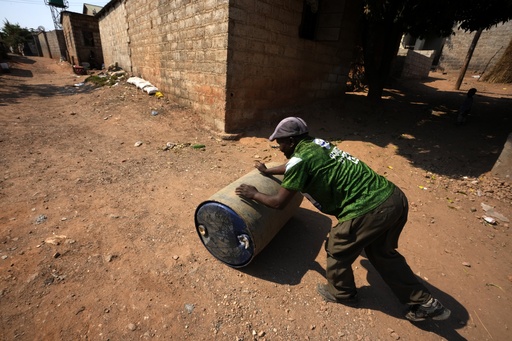LAKE KARIBA, Zambia — Tindor Sikunyongana is currently striving to operate a welding business, which now includes the challenge of purchasing a diesel generator fueled by expensive diesel, a cost that he often struggles to meet.
Like many others in Zambia, Sikunyongana faces the daily reality of finding and affording electricity amid a climate-related energy crisis that has severely diminished the nation’s power supply.
“Only God knows when this crisis will end,” Sikunyongana lamented, as his generator came to a halt due to a lack of diesel. “You see what I mean?”
The southern African nation is experiencing unprecedented electricity blackouts largely due to a significant drought that has significantly affected Lake Kariba, a critical water source for hydroelectric power generation.
Lake Kariba, recognized as the largest man-made lake in volume, is located 200 kilometers south of Lusaka and straddles the border between Zambia and Zimbabwe.
Constructed in the 1950s, the dam wall witnessed the loss of over 80 workers during its building phase, and it aimed to transform the region’s energy supply by harnessing the Zambezi River’s waters to provide sustainable hydroelectric power.
However, prolonged months of drought driven by the El Niño weather phenomenon and intensified by global warming have brought Zambia’s hydroelectric facilities close to total shutdown for the first time.
The water levels have dropped so drastically that only one of the six turbines on Zambia’s side of the dam is operational, producing less than 10% of expected power output.
With Kariba supplying over 80% of the nation’s electricity, citizens are typically left with only a few hours of power daily, while some areas face lengthy outages lasting days.
Edla Musonda has become so frustrated that she now transports her entire desktop setup to a local café to work.
At the Mercato Café in Lusaka, Musonda and several others gather not for food or a pleasant environment, but because the café is equipped with a diesel generator.
The tables are cluttered with power strips as individuals charge their devices, and Musonda, in particular, brings along her home office setup as this has become vital for her small travel business.
Less than half of Zambia’s population of 20 million had reliable access to electricity prior to the ongoing crisis, and many are now adapting as mothers experiment with alternate cooking methods and children work on homework under candlelight.
The crisis has severely impeded small businesses, which are vital to the country’s economy.
“This is likely to aggravate poverty levels in Zambia,” noted economist Trevor Hambayi, who voiced concerns about the potential downturn of the economy if the power outages persist.
He emphasized the need for the Zambian government, as well as other nations, to acknowledge the risks associated with over-relying on a singular source of energy heavily influenced by climatic conditions.
The impact of this energy crisis on the economy and poverty reduction efforts is seen as more severe than the challenges faced during the COVID-19 lockdowns, according to Ashu Sagar, head of the Zambia Association of Manufacturers.
Although Africa contributes the least to global warming, it faces the highest vulnerability to extreme weather due to limited capacity to fund adaptive measures.
The drought currently plaguing southern Africa is among the worst in decades, leading to significant crop failures and hunger, prompting Zambia and other nations to declare states of national disaster and seek international aid.
While hydroelectricity accounts for 17% of Africa’s energy generation, projections indicate this could rise to 23% by 2040, as reported by the International Energy Agency.
Zambia is facing challenges similar to Mozambique, Malawi, Uganda, Ethiopia, and the Congo, where hydroelectric power also constitutes a significant portion of energy mix.
Experts are increasingly advising that reliance on hydroelectric power may no longer be viable due to climate-related fluctuations.
“Extreme weather patterns, such as prolonged droughts, demonstrate that depending on hydroelectric sources is becoming unsustainable,” stated Carlos Lopes, a professor at the University of Cape Town.
In response to the crisis, the Zambian government is encouraging solar power use, yet many citizens find the technology unaffordable.
The government has resorted to using diesel generators for hospitals and other facilities and plans to increase reliance on coal-fired energy generation out of necessity.
In contrast, neighboring Zimbabwe also shares the burden of reduced electricity generation from Lake Kariba, though it obtains a larger portion of its power from coal facilities.
At Lake Kariba, the 128-meter (approximately 420 feet) dam wall is largely exposed, with discolored lines marking previous water levels that were normal a decade ago.
Leonard Siamubotu, a long-time boat cruise operator on the lake, has observed significant changes. With dropping water levels, ancient submerged trees now appear, with one he saw for the first time emerging in the middle of the lake.
Lake levels naturally fluctuate with the seasons, generally rising by about six meters following rainy periods; however, authorities noted a mere increase of less than 30 centimeters after the last rainy season fell short.
There is hope for improved rainfall in the upcoming November season, although it is estimated that it may take at least three years of good rains for Lake Kariba to regain its hydroelectric potential.
Experts caution that this reliance on natural rainfall is precarious amid Zambia’s ongoing struggles with drought-related power issues, which tend to worsen over time.
“Merely waiting for nature isn’t a solution,” warned Hambayi.
This website uses cookies so that we can provide you with the best user experience possible. Cookie information is stored in your browser and performs functions such as recognising you when you return to our website and helping our team to understand which sections of the website you find most interesting and useful.
